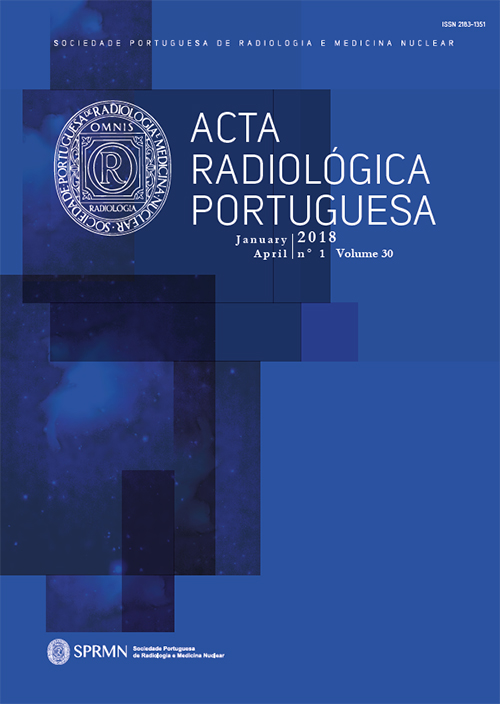Computed Tomography in the Evaluation of Lung Transplant Chronic Rejection
DOI:
https://doi.org/10.25748/arp.13434Resumo
Lung transplantation is an increasingly common therapeutic option in end-stage pulmonary diseases. One of the main causes of medium and long-term graft failure is chronic rejection, clinically represented by bronchiolitis obliterans syndrome. The early diagnosis of chronic rejection allows optimization of immunosuppressive therapy in order to delay its progression.
In this paper, we review and illustrate the characteristics of chronic lung rejection in high-resolution computed tomography to promote its early diagnosis in follow-up examinations.
At an early stage, during the first year after transplantation, subtle features such as reduction of peripheral bronchovascular markers, thickening of the septal lines, and decreased lung volumes may suggest the diagnosis even before clinical changes appear. Mid-term features are represented by bronchiectasis and bronchial wall thickening, and present low sensitivity, but high specificity in the diagnosis of chronic rejection. Its appearance occurs simultaneously with the clinical diagnosis of bronchiolitis obliterans syndrome. Lung attenuation abnormalities appear in late stages of the disease. Air trapping is related with small airway obstruction and mosaic attenuation pattern with ventilation-perfusion mismatch. Fibrotic changes of the lung parenchyma characterize advanced stages of chronic graft rejection, leading to important functional repercussion.
High-resolution computed tomography has helped to overcome the limitations of clinical criteria in the diagnosis of obliterans bronchiolitis syndrome and promoted an earlier diagnosis of chronic rejection after lung transplantation.
Referências
Ng YL, Paul N, Patsios D, Walsham A, Chung T-B, Keshavjee S, et al. Imaging of lung transplantation: review. AJR Am J Roentgenol. 2009;192(3 Suppl): S1-13, NaN-9.
Krishnam MS, Suh RD, Tomasian A, Goldin JG, Lai C, Brown K, et al. Postoperative complications of lung transplantation: radiologic findings along a time continuum. Radiographics. 2007;27(4):957–74.
Ikonen T, Kivisaari L, Taskinen E, Piilonen A, Harjula AL. High-resolution CT in long-term follow-up after lung transplantation. Chest. 1997;111(2):370–6.
Murray JG, McAdams HP, Erasmus JJ, Patz EF, Tapson V. Complications of lung transplantation: Radiologic findings. Am J Roentgenol. 1996;166(6):1405–11.
Cooper JD, Billingham M, Egan T, Hertz MI, Higenbottam T, Lynch J, et al. A working formulation for the standardization of nomenclature and for clinical staging of chronic dysfunction in lung allografts. International Society for Heart and Lung Transplantation. J Hear Lung Transpl. 1993;12(5):713–6.
Siegel MJ, Bhalla S, Gutierrez FR, Hildebolt C, Sweet S. Post-lung transplantation bronchiolitis obliterans syndrome: usefulness of expiratory thin-section CT for diagnosis. Radiology. 2001;220(2):455–62.
Leung AN, Fisher K, Valentine V, Girgis RE, Berry GJ, Robbins RC, et al. Bronchiolitis obliterans after lung transplantation: Detection using expiratory HRCT. Chest. 1998;113(2):365–670.
Worthy SA, Park CS, Kim JS, Muller NL. Bronchiolitis obliterans after lung transplantation: high-resolution CT findings in 15 patients. AJR Am J Roentgenol. 1997;169(3):673–7.
Konen E, Gutierrez C, Chaparro C, Murray CP, Chung T, Crossin J, et al. Bronchiolitis obliterans syndrome in lung transplant recipients: can thin-section CT findings predict disease before its clinical appearance? Radiology. 2004;231(2):467–73.
Knollmann FD, Ewert R, Wündrich T, Hetzer R, Felix R. Bronchiolitis obliterans syndrome in lung transplant recipients: use of spirometrically gated CT. Radiology. 2002;225:655–62.
Bankier AA, Van Muylem A, Knoop C, Estenne M, Gevenois PA. Bronchiolitis obliterans syndrome in heart-lung transplant recipients: diagnosis with expiratory CT. Radiology. 2001;218(2):533–9.
Downloads
Ficheiros Adicionais
Publicado
Edição
Secção
Licença
CC BY-NC 4.0


